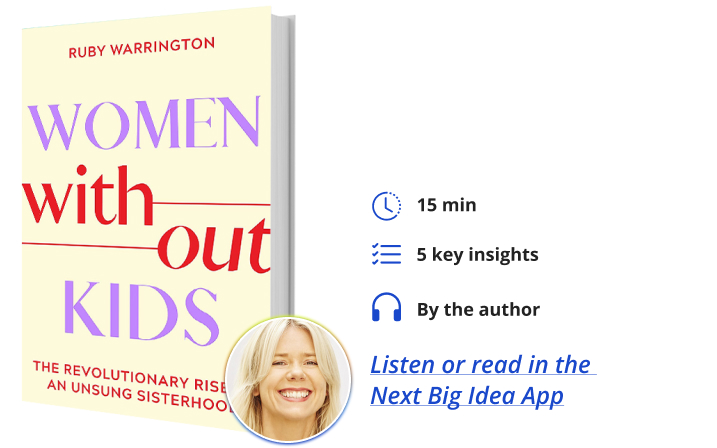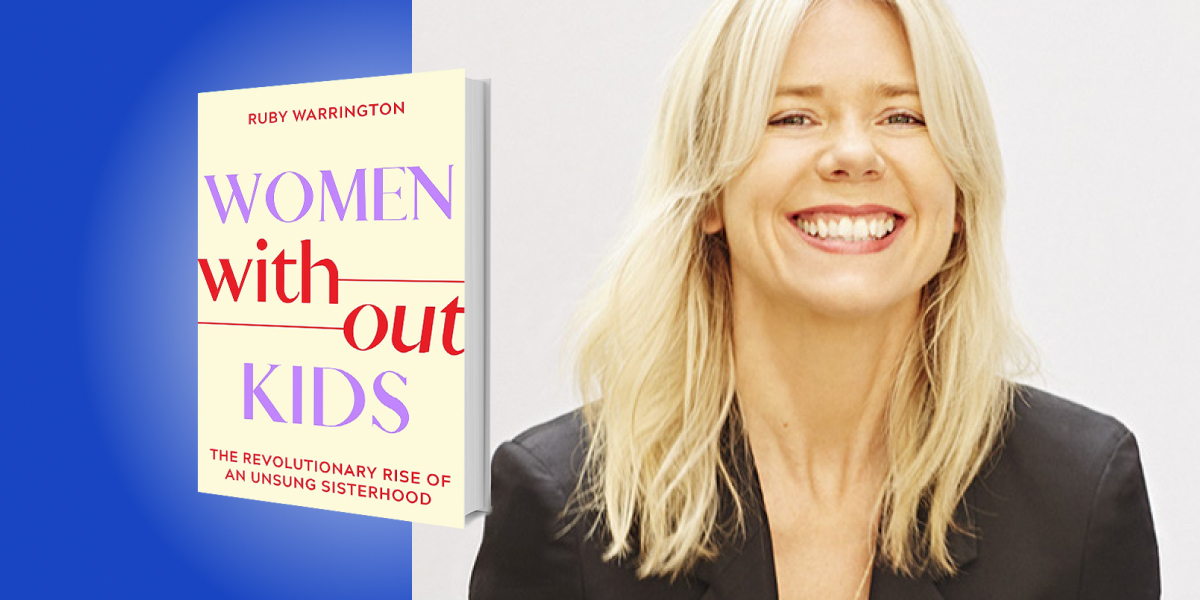Ruby Warrington is an author with over 20 years of experience as a lifestyle journalist and editor. She is also the founder of self-publishing incubator, Numinous Books.
Below, Ruby shares 5 key insights from her new book, Women Without Kids: The Revolutionary Rise of an Unsung Sisterhood. Listen to the audio version—read by Ruby herself—in the Next Big Idea App.

1. The “motherhood spectrum.”
We are told that motherhood is every woman’s rightful, natural role, and her ultimate path to fulfillment. But a person’s desire and aptitude for parenthood are influenced by a multitude of factors—everything from our basic personality, to the family and culture we were raised in, to our relationship status, our finances, the demands of our work, to our artistic and creative ambitions. Increasingly, concerns about the environment are also factoring into people’s decisions about their procreative potential.
Taking all of this into account, I present the idea of the motherhood spectrum: How any one woman feels about having children, where she orients on the spectrum, may shift as her circumstances shift, and some of us will always be more suited to the vocation of parenting than others.
2. All women without kids are “childless-by-circumstance.”
Traditionally, women without kids have been divided into two camps: the “can’t have kids” and the “won’t have kids.” In the case of the former, this is often assumed to be due to fertility issues, with the “can’t have kids” sometimes being described as the “childless-not-by-choice.” In the case of the “won’t have kids,” the defiantly “childfree,” are often seen as selfish, deviant, or perhaps cold and heartless, as if they are missing the nurturance gene. But the concept of the “motherhood spectrum” shows us that the story is far more nuanced than that, and perhaps all women without kids are in fact “childless-by-circumstance.”
“Circumstances include everything.”
Circumstances include everything. They can include being raised in a dysfunctional family that you have no desire to replicate, having big ideas that you want to birth before you birth a child, and being queer or trans. On top of this, human fertility overall has fallen dramatically over the past four decades due to toxic environmental factors, circumstances all of which have a profound effect on a person’s reproductive outcomes.
3. There is no such thing as a biological maternal instinct.
As evolutionary biologist Gillian Ragsdale pointed out when asked about this, we do not talk about there being a biological “paternal instinct.” If the desire to procreate were indeed a function of human biology, then it should apply equally to both sexes. What we need, when it comes to the replication of the species, is a sex drive. If we have enough unprotected sex, most of it non-procreative, then eventually babies will follow. At this point, it is very helpful if there is a natural instinct to nurture and protect our offspring. Ideally, this instinct would apply across the gender spectrum.
This suggests that the all-consuming desire to have a child, sometimes referred to as “baby fever,” is more of a social construct than a biological imperative. This idea is designed to reinforce the notion that motherhood is every woman’s “natural” role. A socially constructed instinct can feel very real, but when a woman decides that she wants to have a child, she is not following the directive of her biological function. She is deciding that she wants to experience a specific kind of love; that she wants to perform a certain role; perhaps, that she wants to be accepted and seen as a valid member of society.
4. Everything changed with Generation X.
Women born in places like the United States from the late 1960s up until 1980 are the first generation of girl babies to have received the message “you can do and be whatever you want” from birth. Thanks to the gains of the women’s liberation movement, these girls would also be the first to come of age with ready access to effective, accessible birth control, safe and legal abortion, equal access to education and career opportunities, and the ability to create financial independence for themselves.
“We are witnessing an influx of older, wiser ladies without babies, who are not nearly so unfulfilled and regretful in their childlessness as predicted.”
These women are reaching the end of their reproductive years in the 2020s. The vast majority of these women had far fewer children than in previous generations—the number of single-child households in the US has doubled since 1976—and many had no children at all. As a result, we are witnessing an influx of older, wiser ladies without babies, who are not nearly so unfulfilled and regretful in their childlessness as predicted. They are poised to become powerful role models for younger women who are on the fence about whether or not to have kids.
5. Engage your generativity to leave another legacy.
Psychologist Erik Erikson’s concept of generativity provides insights into how to make your life count when you don’t have children. The seventh of Erikson’s 8 Stages of Psychosocial Development, generativity, speaks to “a concern for establishing and guiding the next generation.” Erikson did not consider becoming a biological parent as necessary for enacting generativity, which social scientists tell us can be engaged with on a biological, parental, technical, cultural, and societal level.
We engage our generativity when we take on teaching and mentoring roles; when we become cultural parents, helping shape the culture with our business and creative endeavors; and when we take on an active role in our community. Perhaps the greatest clue as to what it means to enact generativity is that it sounds like “generous activity.” In some way, shape, or form, acts of generativity have the potential to benefit others. This is a powerful legacy to think about, regardless of whether or not we have kids.
To listen to the audio version read by author Ruby Warrington, download the Next Big Idea App today:































